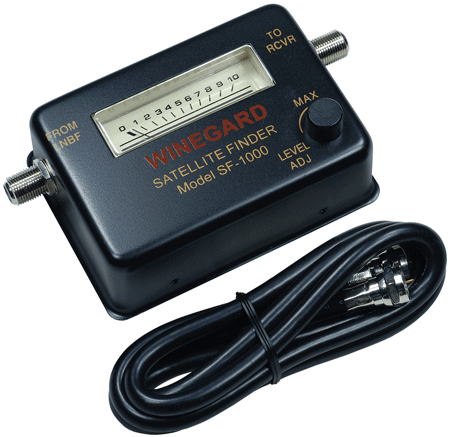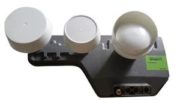.You may have noticed that you can buy a signal finder like this one very inexpensively while other meters like our AIM are priced much much higher. Both are used to help you aim satellites, so the question in your mind is probably “why would I pay ten times as much when I could get the less expensive one?”
The difference between a bright spot and a camera
And it’s a good question too, and it’s worth explaining the difference between the lower-priced item and the higher priced one. Although we casually describe both as meters, really the better term for the SF-1000 you see at the top of the page is a “signal finder.” It’s really just sort of a radio and nothing else. It picks up the frequencies used by most satellites (known as the Ku-band) and gives you an indication of basic signal strength. That should be all you need if you’re aiming a round dish, but you need a lot more for an HD dish.
The AIM and other expensive satellite meters are a lot more than just radios. They actually interpret the digital information in the signal, making them more like portable, battery-powered satellite receivers. They can tell you not only the signal strength but several other important measurements like MER (modulation error rate) BER (bit error rate) and CNR (carrier to noise ratio.) Without getting too technical, these are important characteristics of any digital signal and in some cases they do a better job predicting whether or not you’ll get a good picture on the TV. They not only figure out all this information but they also show you in easy-to-understand terms whether a signal is good or not.
Let’s put it this way. If you are in a room with a window, you can look away from the window and see a bright spot on the wall. This tells you if it’s dark or light outside. If you want to know more you have to look out the window, where you can get all the detail you want. In this scenario, the signal finder is like looking at the wall. It just gives you the most basic information. An expensive signal meter is like looking out the window: it will give you the whole picture.
Aiming DIRECTV dishes
If you have a DIRECTV HD or 4K dish you will need to use a more expensive satellite meter, whether or not that dish has SWM technology built-in. DIRECTV uses a different set of frequencies (known as the Ka band) to send its HD signals from space. DIRECTV is the only provider that uses the Ka band. That gives them the capacity for thousands of HD channels. That’s a good thing, right?
Unfortunately those inexpensive signal finders won’t read the Ka band. This means they can’t really be used to aim an HD dish. The news gets even worse with a SWM-enabled dish. At least with a non-SWM dish you could get a signal off the primary “101” satellite for DIRECTV. With a SWM-enabled dish you would get nothing from a signal finder, not even a blip.
The choice is really yours. If you’re using a DIRECTV SWM dish you could use the satellite finder to get a basic aim. Then you could use your receiver’s built-in signal meters for the rest. You could invest in a meter that will make aiming easy no matter what dish you use.
Aiming DISH dishes
HD Dish aiming for DISH isn’t necessarily any easier. The AIM is exclusive to DIRECTV, and the SatLookLite will work with Western Arc not Eastern Arc. We recommend the Birdog Ultra for aiming Eastern Arc dishes. It’s expensive, but it’s the only meter that will work reliably.
Which is best for you?
Let’s say you’re aiming a simple round dish. All you need to know is if you have signal at all. In this case a satellite finder will give you everything you need. However, let’s say you want to aim one of the more complex and modern dishes from DIRECTV or DISH. You’ll need some sort of more expensive signal meter. Luckily you can find what you’re looking for at SolidSignal.com.





